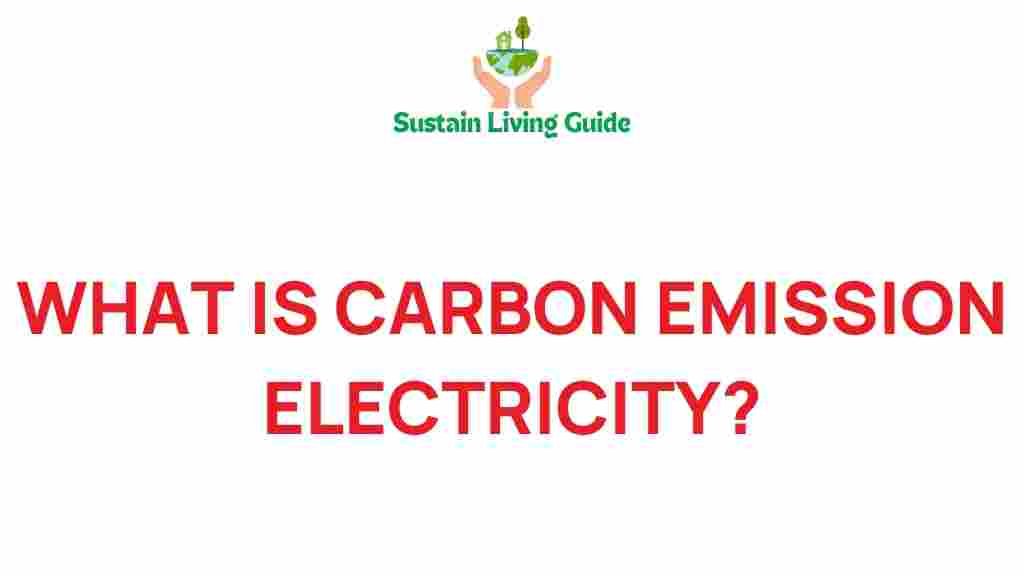Understanding Carbon Emission in Electricity Generation
Carbon emissions have become a significant concern in today’s world as we strive for a cleaner and more sustainable future. The electricity sector, being one of the largest contributors to carbon emissions, plays a crucial role in this challenge. Transitioning to clean energy sources not only helps in reducing these harmful emissions but also paves the way for a healthier planet.
In this article, we will delve into the dynamics of carbon emissions in electricity generation, explore various clean energy alternatives, and offer insights on how individuals and businesses can contribute to a reduction in carbon footprints.
What Are Carbon Emissions?
Carbon emissions refer to the release of carbon dioxide (CO2) into the atmosphere, primarily from the burning of fossil fuels for energy production. This process occurs in various industries, including electricity generation, transportation, and manufacturing.
The Impact of Carbon Emissions
High levels of carbon emissions contribute to global warming and climate change, leading to severe environmental consequences such as:
- Rising global temperatures
- Melting ice caps and rising sea levels
- Increased frequency of natural disasters
- Threats to biodiversity
Addressing carbon emissions is essential for mitigating these impacts and ensuring a sustainable future.
Sources of Carbon Emission in Electricity Generation
The electricity generation sector is responsible for approximately 42% of global carbon emissions. The primary sources include:
- Fossil Fuels: Coal, natural gas, and oil are the main culprits, releasing significant amounts of CO2 when burned.
- Industrial Processes: Certain manufacturing processes also contribute indirectly to carbon emissions through energy consumption.
- Deforestation: Trees absorb CO2, and their removal releases stored carbon back into the atmosphere.
Transitioning to Clean Energy
To combat carbon emissions effectively, a transition to clean energy sources is imperative. Here are some of the most promising alternatives:
1. Solar Energy
Solar power harnesses energy from the sun, a renewable source that produces no direct carbon emissions. By installing solar panels on rooftops or utilizing solar farms, both individuals and businesses can significantly reduce their reliance on fossil fuels.
2. Wind Energy
Wind turbines convert wind energy into electricity without producing carbon emissions. Wind energy is one of the fastest-growing energy sources globally, and advancements in technology continue to enhance its efficiency.
3. Hydroelectric Power
Hydroelectric power uses the flow of water to generate electricity. While it can have environmental impacts, it is generally a cleaner alternative to fossil fuels. Proper management can minimize disruptions to local ecosystems.
4. Geothermal Energy
Geothermal energy taps into the Earth’s internal heat to generate electricity. It is a reliable and consistent energy source with minimal carbon emissions, making it an appealing option for sustainable energy production.
5. Biomass Energy
Biomass energy is derived from organic materials, such as plant and animal waste. When managed sustainably, biomass can be a renewable energy source that offers lower carbon emissions compared to fossil fuels.
Step-by-Step Process to Reduce Carbon Emissions in Electricity Usage
Reducing carbon emissions in electricity usage involves a series of actionable steps:
Step 1: Assess Your Current Energy Consumption
Begin by evaluating your energy consumption patterns. Understand which appliances use the most energy and during what times. This assessment will help identify areas for improvement.
Step 2: Switch to Energy-Efficient Appliances
Invest in energy-efficient appliances that consume less electricity. Look for the ENERGY STAR label, which indicates compliance with energy efficiency guidelines.
Step 3: Utilize Renewable Energy Sources
Consider transitioning to renewable energy sources such as solar or wind. Many utility companies offer green energy programs that allow you to support clean energy production.
Step 4: Implement Smart Home Technology
Smart home devices can optimize energy usage by allowing you to control lighting, heating, and appliances remotely. This technology helps reduce unnecessary energy consumption.
Step 5: Educate Yourself and Others
Stay informed about carbon emissions and energy efficiency. Share your knowledge with friends, family, and your community to encourage collective action towards reducing carbon footprints.
Troubleshooting Common Issues in Reducing Carbon Emissions
In your journey to minimize carbon emissions, you may face certain challenges. Here are some troubleshooting tips:
1. High Initial Costs of Renewable Energy
While the upfront costs of solar panels or wind turbines can be significant, consider options such as government incentives, tax credits, or financing plans to alleviate financial burdens.
2. Limited Space for Installation
If space is a constraint for solar panels, explore community solar programs that allow you to invest in solar energy projects without needing physical space.
3. Uncertainty About Energy Efficiency Measures
Consult with energy auditors who can provide personalized recommendations for improving energy efficiency in your home or business.
4. Resistance to Change
Encourage discussions about the benefits of reducing carbon emissions. Sometimes, understanding the long-term advantages can mitigate resistance to adopting new practices.
Conclusion: The Future of Carbon Emission Reduction
As we continue to face the critical challenge of climate change, understanding and addressing carbon emissions in electricity generation is more important than ever. The transition to clean energy sources not only combats global warming but also fosters innovations and economic opportunities.
By taking small yet impactful steps, we can all contribute to a sustainable future. Whether through personal choices or community initiatives, reducing carbon emissions is a collective responsibility that ensures a healthier planet for generations to come.
For more information on clean energy initiatives, visit Clean Energy Solutions.
To learn more about how to monitor your carbon footprint effectively, check out Carbon Footprint Tracker.
This article is in the category Energy and created by SustainLivingGuide Team

1 thought on “Unveiling Carbon Emission Electricity: The Power Behind Clean Energy”